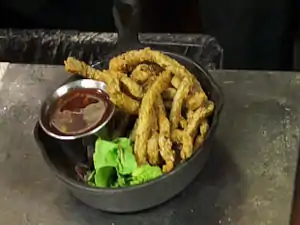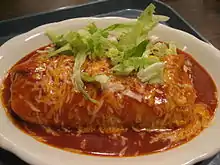Cuisine of the Southwestern United States
The cuisine of the Southwestern United States is food styled after the rustic cooking of the Southwestern United States. It comprises a fusion of recipes for things that might have been eaten by Spanish colonial settlers, cowboys, Native Americans,[1] and Mexicans throughout the post-Columbian era; there is, however, a great diversity in this kind of cuisine throughout the Southwestern states.
| Part of a series on |
| American cuisine |
|---|
|

Southwestern cuisine is similar to Mexican cuisine but often involves larger cuts of meat, namely pork and beef, and less use of tripe, brain, and other parts not considered as desirable in the United States. As with Mexican cuisine, Southwestern cuisine is also largely known for its use of spices (particularly the chile, or chili pepper). Recently, several chains of casual dining restaurants specializing in Southwestern cuisine have become popular in the United States.
New Mexican cuisine is known for its dedication to the chile (the official "state question" is "Red or green?" which refers to the preferred color of chiles), most notably the Hatch chile, named for the city in New Mexico where they are grown. Part of the New Mexican cuisine is smothering each dish with either red chile, green chile or both (mixing of both is referred to as "Christmas"). And the usage of pork or beef. The New Mexican Cuisine is most popular in the states of New Mexico, Colorado, and Utah. Texas has a version, Tex-Mex cuisine, while Arizona's style of Southwestern cuisine is often called Sonoran, since the Sonoran Desert covers a third of the state.
Characteristics
The staple ingredients of Southwestern cuisine are corn, squash and beans. Called the "three sisters", they have been staples of North American agriculture since ancient times. Beans are served whole or refried, and both styles can be used as filling for tostadas, tacos, burritos and similar dishes. Many bean varieties are consumed but the pinto bean is the most iconic bean of southwestern cuisine.[2]
Southwestern food is distinguished by the use of chile peppers as the primary seasoning, first brought to Santa Fe with the arrival of the Spanish from Mexico. Chile peppers are used as a topping for virtually every dish from pizza to bagels, or just fried tempura and eaten whole. Most dishes, from burritos to scrambled eggs, are served with plentiful amounts of chile sauce.[2]
States
Arizona

The cuisine of Arizona is influenced by its location and proximity to Mexico and reflects a blend of Hispanic, Native American and pioneer culinary traditions. The O'odham peoples cultivated crops like maize and tepary beans around the Sonoran Desert area located at the base of the Tucson Mountains.[3]
Local dishes include raspado, huevos rancheros and tamales. The Sonoran hot dog is an Arizona specialty served with pinto beans, guacamole, jalapenos, salsa and layered with other southwestern flavors.[4]
Tucson, Arizona became the first American city to receive the designation of "City of Gastronomy" by UNESCO. Restaurants use local ingredients, many grown with heirloom seeds distributed by non-profit organizations like Native Seeds/SEARCH.[3] Salads and salsas are made with cholla cactus, gathered and dried at the San Xavier Indian Reservation.[5]
Nevada
The cuisine of Nevada is influenced by Basque cuisine, with many Basque restaurants in the area of Las Vegas and a Basque festival in Elko. Originally invented in California, Picon Punch is a signature drink not often found outside Nevada in modern times.[6]
New Mexico
The most prevalent cuisine type of New Mexico, and the American Southwest, is that of the cuisine originating in the historical region of Santa Fe de Nuevo México. The modern New Mexican cuisine is a fusion the cuisine of the Puebloans and Hispanos of New Mexico.
Utah

Potatoes were the first crop planted by the pioneers when they arrived in the Salt Lake Valley in 1847 with seeds from the eastern states. According to William Clayton the first settlers in Utah also planted turnips, oats, corn, buckwheat and beans. Peach pits and apple seeds were planted at the insistence of Brigham Young. Veterans of the Mexican–American War brought back seeds from California, introducing club wheat and the California pea to the state.[7]
In modern times Utah is not noted for its culinary traditions except its "Fry Sauce", a mix of ketchup and mayonnaise that is served with nearly everything.[8]
Southwestern dishes


- Albondigas de pollo
- Arizona/California burrito
- Arizona cheese crisp
- Burrito
- Cactus fries
- Chili con carne
- Chili con queso
- Chile relleno
- Chimichanga
- Enchilada casserole
- Enchiladas
- Fajitas
- Flan
- Huevos rancheros
- Jalapeño poppers
- King Ranch chicken
- Menudo
- Nachos
- New Mexico breakfast burrito
- Pozole
- Quesadilla
- Rice and beans
- Rocky Mountain Oysters
- Salsa
- Slopper
- Sopapillas
- Tacos
- Tamale pie
- Taquitos
- Tostadas
See also
- Elia Aboumrad
- Jackie Alpers, author of the Taste of Tucson cookbook
- Jane Butel, author on the subject
- Susan Feniger, author, television host and co-proprietor of the famed Border Grill
- Mary Sue Milliken, author, television host and co-proprietor of the famed Border Grill
- Stephan Pyles, author and restaurateur
- Aarón Sanchez
- Marcela Valladolid
- New Mexican cuisine
References
- "Native Americans." (cached version). Ed101.bu.edu Archived 2011-08-24 at the Wayback Machine. Accessed July 2011.
- "A Cheat Sheet to Southwestern Food". Eater.
- "What Makes Tucson Deserving of the Title of the United States' First Capital of Gastronomy". Smithsonian Magazine.
- Mercuri, Becky (2007). The Great American Hot Dog Book:Recipes and Side Dishes from Across America. Gibbs Smith. p. 115.
- "Tucson Becomes an Unlikely Food Star". The New York Times. August 23, 2016.
- "The origin of the Picon punch, a quintessential Western cocktail". Reno Gazette-Journal. August 10, 2017.
- Cheney, Brock. Plain by Wholesome: Foodways of the Mormon Pioneers. University of Utah Press. p. 26.
- "Utah ranks 47th for states with the best food scenes, travel site says". KUTV. November 6, 2020.
Further reading
- Nusom, Lynn (1999.) "Authentic Southwestern Cooking." Western National Parks Association. ISBN 1-877856-89-4
- Curtis, Susan (1995.) "The Santa Fe School of Cooking Cookbook: Spirited Southwestern Recipes." Gibbs Smith. ISBN 0-87905-619-3, ISBN 0-87905-873-0